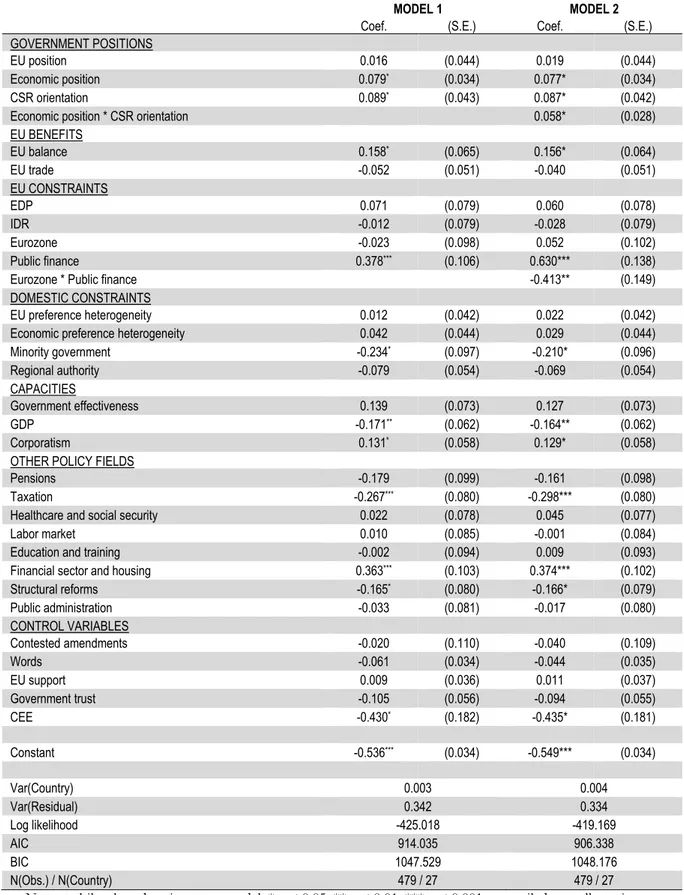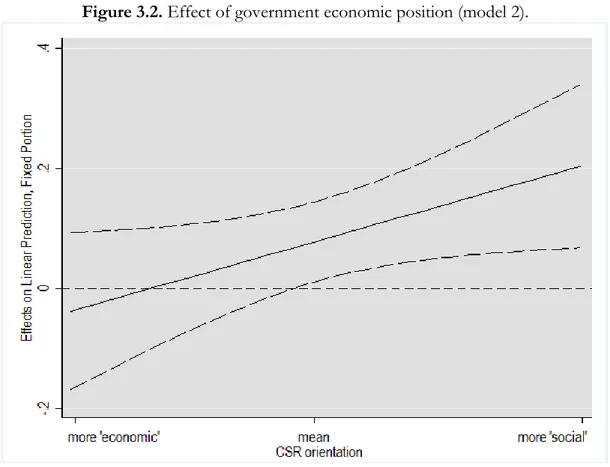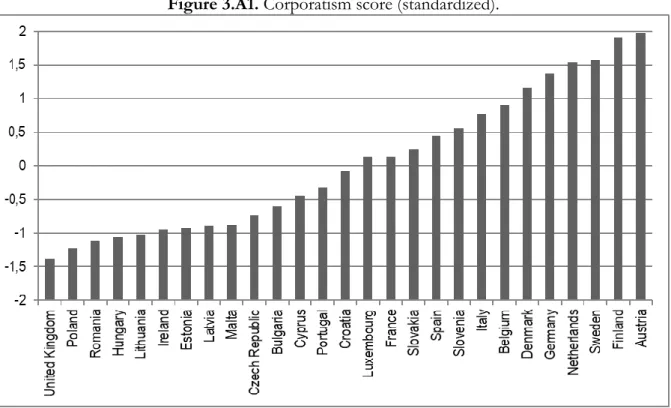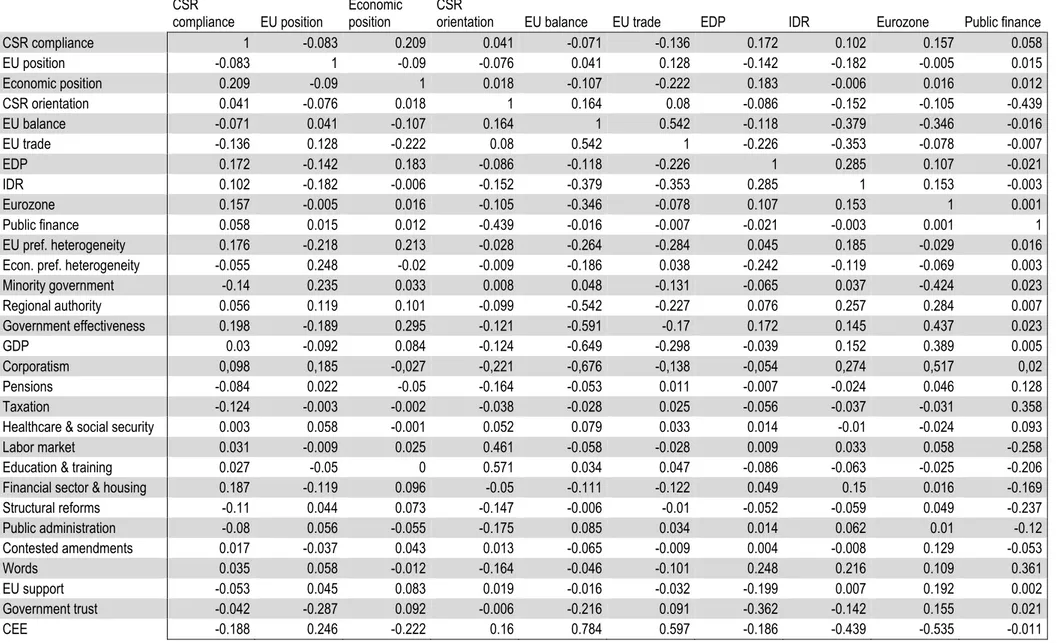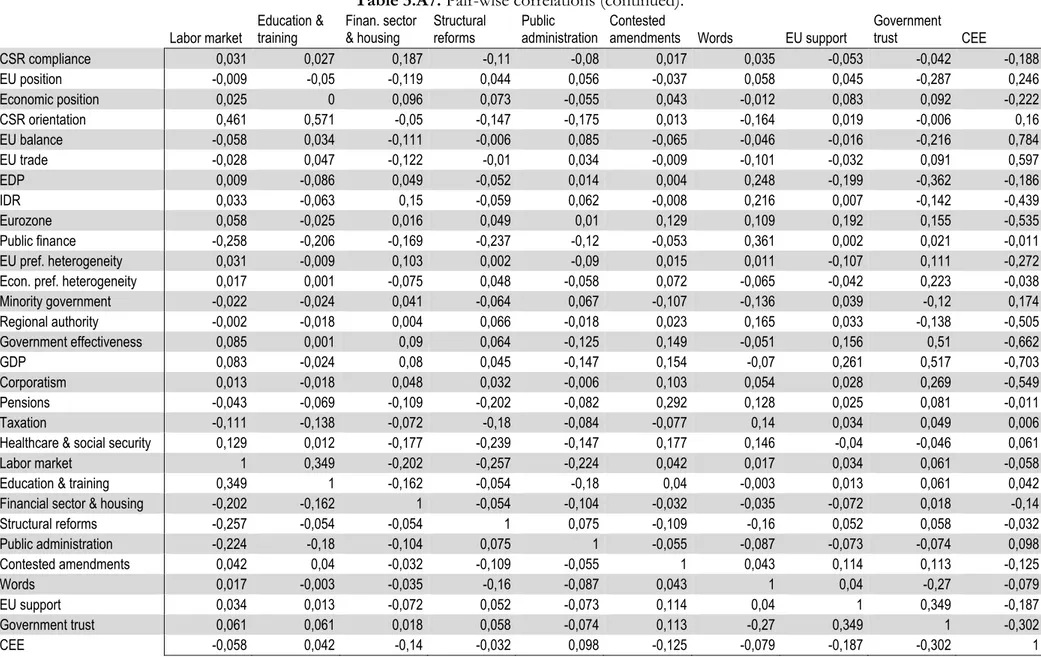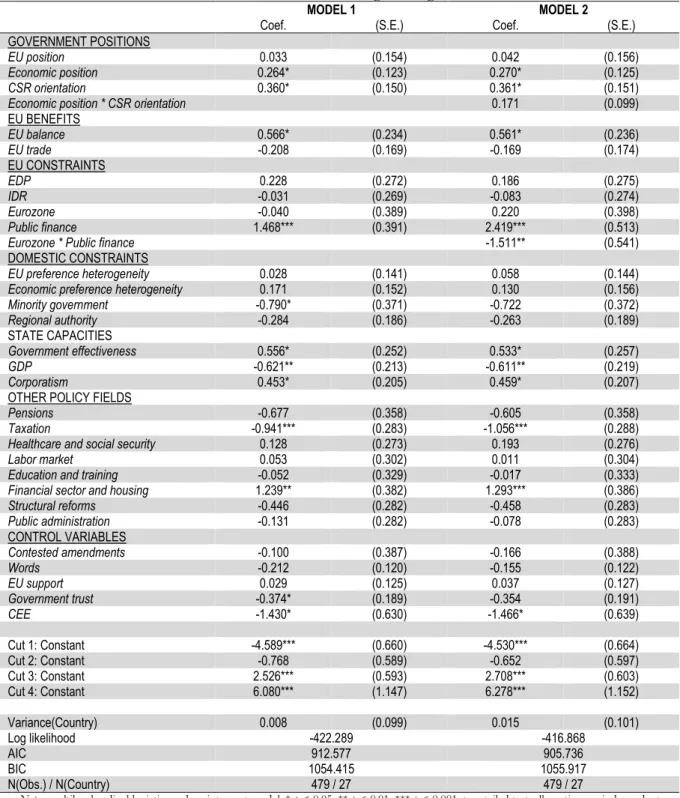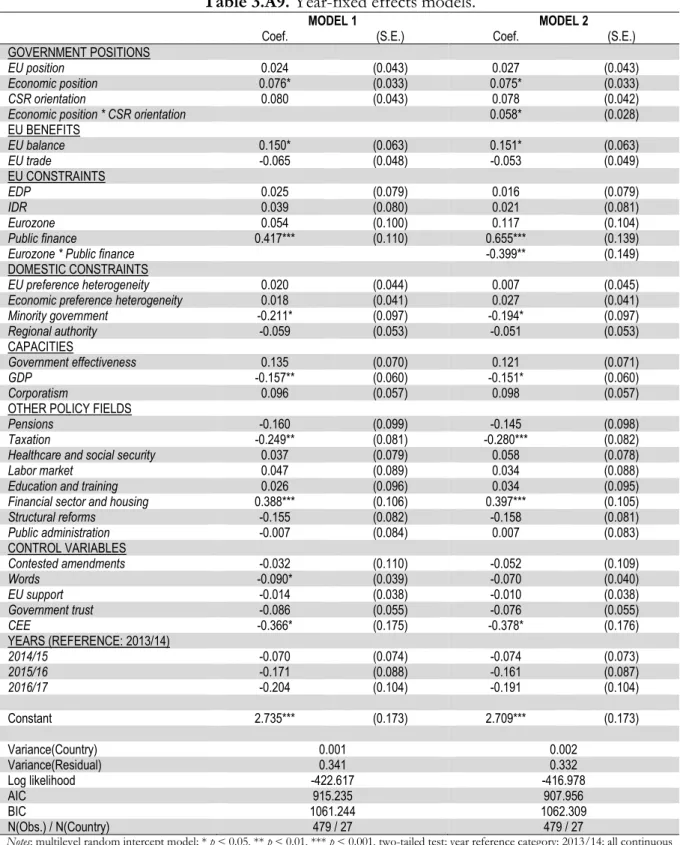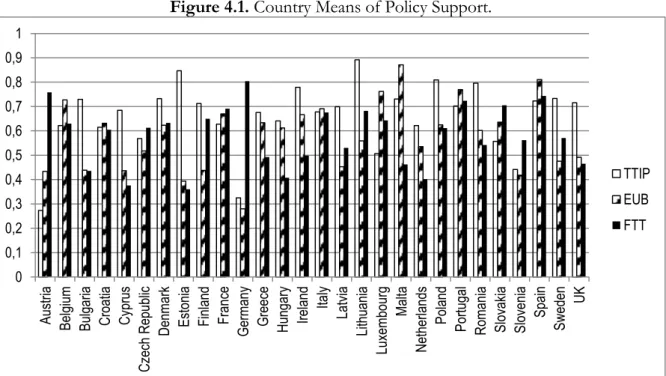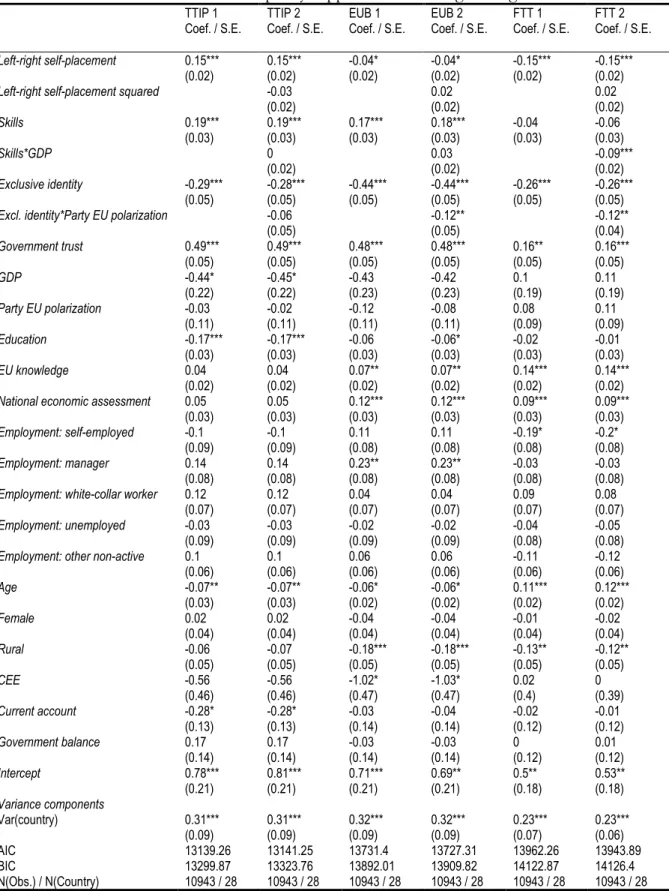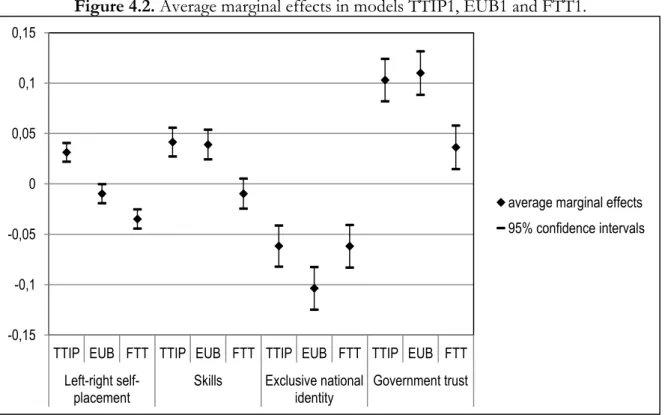Re-Defining Europe:
Decision-Making, Implementation and Support of Economic Policies of the European Union
Inauguraldissertation zur
Erlangung des Doktorgrades der
Wirtschafts- und Sozialwissenschaftlichen Fakultät der
Universität zu Köln
2018
vorgelegt von
Leon Kanthak, Dipl.-Pol.
aus Berlin
Referentin: Prof. Dr. Christine Trampusch
Korreferent: Prof. Dr. André Kaiser
Tag der Promotion: 26.06.2018
To my parents
The project of this dissertation has been with me for the past four and a half years and my process of thinking about its subject – EU economic policies – started well before that. It has been a long and sometimes exhausting journey. That it also turned out to be a highly rewarding experience and that my fascination with the topic remains unabated is largely thanks to the many people who supported me along the way. For this, I am deeply grateful.
First, I would like to thank my supervisor Prof. Dr. Christine Trampusch. Without her guidance and support, especially when I struggled with seemingly intractable problems, this dissertation would not have been possible. Her deep knowledge of political economy and her clear analytical thinking helped me decisively in specifying my research questions and in coming up with more coherent and convincing strategies to answer them. Our talks about the project and individual papers left me more motivated and with fresh ideas, so that I kept going rather than giving up.
I would also like to thank Prof. Dr. André Kaiser, Prof. Dr. Sven-Oliver Procksch, Prof. Ingo Rohlfing, Ph.D. and the other participants of the research seminar of the Cologne Center for Comparative Politics (CCCP). I presented two studies that are part of this dissertation in this context. The many insights that I gained through the feedback I received on these, but also through listening to the presentations on projects of my fellow colleagues, helped me immensely in improving my own research.
At the risk of repeating myself, I would also like to express my gratitude to all of my colleagues of the CCCP. The Center is a great place to do research and to exchange views on research surrounded by a group of highly motivated and supportive people. Special thanks goes to Philip Gross with whom I had the pleasure to share a room for the four and a half years I worked here. It was great to have someone to talk with about the problems we were facing in the course of our research, but also about issues entirely unrelated to the work context. From my experience, procrastination and
distraction are also an essential part of a dissertation project and it is surely more pleasant to procrastinate and be distracted together. Moreover, I should mention that Philip helped me with his expertise to resolve many big and small administrative and technical issues. As I know, he is concerned that this might have decreased the slope of my learning curve in this respect, but I am convinced he also taught me to improve my own abilities to deal with such problems independently.
Furthermore, I am very grateful to Dr. Dennis C. Spies. He is the co-author of one of the studies compiled in this dissertation. It was a pleasure to work with him and to profit from his highly structured, organized and pragmatic way of thinking. In terms of doing research, I always thought of myself as more of a ‘lone wolf’, but working with Dennis proved to be highly productive and, yes, fun. Dennis is also among the select few to have read and provided valuable insights on all studies compiled in this dissertation. In particular, his abilities to spot weaknesses quickly and to come up with constructive ideas of how to address them are truly remarkable. Furthermore, I am thankful for his continuous encouragement and support as well as his unique brand of humor.
An incomplete list of other people from the CCCP and its wider orbit who provided important insights, comments and ideas include, in no particular order, Dennis Abel, Florian Fastenrath, Armin Mertens, Agnes Orban, Michael Schwan, Nawid Hoshmand, Stephan Vogel, Dr. Alexander Spielau, Leonce Röth and Holger Reinermann. Each of them made more than one unique contribution to the refinement of my thoughts and knowledge about theory, methods, and empirics. I should also mention that my engagement with the topic of the dissertation, EU economic policies, precedes my time at the CCCP. During my studies at the Freie Universität Berlin and the University of Kent, Prof. Dr. Michael Bolle and Dr. Jane O’Mahony in particular contributed to sparking my interest in this specific object of political science research and supported my decision to pursue a doctoral study in political economy.
The work on this dissertation has been an important part of my life for the past four years, but I am glad to say that it has not been the only part that mattered. In this context, the support of family and friends also helped me immeasurably. First, I would like to mention my parents, Gerhard and Angela, without whose unconditional love, unwavering support and belief in my abilities throughout my life the completion of this project would have been unthinkable. Thanks also to my loving partner Inga who, more than anyone else, had to deal with my frustration and anger in the process and never grew impatient with my – I am sure oftentimes repetitive and unfair – complaints. She also ensured that I was able to maintain an overall healthy work-life balance and that the ‘life’ component did not deteriorate in quality during periods when the quantity of time I had for this was relatively low. Finally, I am grateful to my friends ‘back home’ in Berlin. Having such a close-knit and loyal circle of people around me, even as I was living in the far West, helped me to keep in mind what a great privilege friendship can be.
Chapter 1: Introduction ...1
1.1 Introduction ... 2
1.2 State of the art: the new EU economic governance ... 5
1.2.1 The making of EU economic policy at the EU level ... 6
1.2.2 The implementation of EU economic policy at the national level ... 15
1.2.3 The reception of EU economic policy at the individual level ... 21
1.3 Overview of studies ... 27
1.3.1 Case selection and methodology ... 28
1.3.2 Results and contributions ... 31
1.3.3 Status of studies and contribution of co-author ... 36
1.4 References ... 37
Chapter 2: Supranational or Intergovernmental? The Making of the Macroeconomic Imbalance Procedure ... 53
2.1 Introduction ... 54
2.2 The MIP ... 55
2.3 Supranational or intergovernmental? ... 56
2.4 The approaches of supranational actors ... 59
2.5 The approach of the Council ... 63
2.7 Making it happen ... 68
2.8 Conclusions ... 73
2.9 Appendix: interviews ... 75
2.10 References ... 76
Chapter 3: Compliance with Country-Specific Recommendations under the
European Semester ... 83
3.1 Introduction ... 84
3.2 Compliance with CSRs: conceptualization and measurement ... 85
3.3 Explaining compliance with EU recommendations ... 88
3.3.1 Enforcement approach ... 88
3.3.2 Management approach ... 92
3.4 Data and measurement ... 94
3.4.1 Independent variables ... 94
3.4.2 Control variables ... 96
3.5 Results ... 97
3.6 Conclusion ... 103
3.7 Appendix ... 106
3.7.1 Variable coding and sources ... 106
3.7.2 Descriptive statistics ... 114
3.7.3 Additional models ... 119
3.7.4 Corporatism data ... 121
3.7.5 CSR sources ... 122
3.8 References ... 130
Chapter 4: Public Support for EU Economic Policies ... 135
4.1 Introduction ... 136
4.2 EU economic policies: TTIP, Eurobonds and FTT ... 138
4.3 Explaining support for EU economic policies ... 139
4.3.1 Political ideology ... 139
4.3.2 Utility ... 141
4.3.3 Identity ... 143
4.3.4 Cue-taking ... 145
4.4 Data and method ... 147
4.4.1 Dependent variables ... 148
4.4.2 Independent variables ... 149
4.4.3 Control variables ... 150
4.5 Results ... 151
4.6 Conclusion ... 158
4.7 Appendix ... 160
4.7.1 Data ... 160
4.7.2 Variable coding ... 160
4.7.3 Descriptive statistics ... 165
4.7.4 Marginal effect plots for models with interaction effects ... 167
4.7.5 Differences of coefficients ... 170
4.7.6 Inspection of missing values ... 171
4.7.7 East-West differences ... 172
4.7.8 Ordered logits for Eurobonds and FTT support ... 173
4.7.9 Interpretation of ‘don’t know’ answers ... 175
4.7.10 Results of media analysis ... 178
4.8 References ... 181
Chapter 1: Introduction
1.1 Introduction
In the 1970s, Donald Puchala (1971) famously likened theorizing international integration in general and European integration in particular, located in between national and international politics, with blind men touching various parts of a (growing) elephant and consequently disagreeing strongly about the nature of the beast. Since then, the European Union (EU) has only become more complex – and so has the set of theories applied to describe, conceptualize and explain it. The goal of establishing consensus on a single unified theoretical framework to understand the EU thus appears ‘as elusive as ever’ (Pollack 2015: 26), the field resembling ‘a mosaic providing a multifaceted and never complete picture’ (Wiener and Diez 2009: 243). At the same time, various mid-range theories, often drawn from different sub-fields of political science such as international relations, comparative politics or political behavior, have been fruitfully applied to it (Pollack 2015). The political system of the EU, the elephant, may be sui generis, but its constituent parts are all familiar to political scientists. If (national and international) politics is all about who gets what when and how, the same is certainly the case for European politics and there is no a priori reason to expect that distributional and ideological conflicts characterize the process of decision-making to a lesser extent than at the national or international level.
This is nowhere more obvious than in EU economic policy-making. The effects of economic policy choices on the actual distribution of resources both within and across societies is particularly obvious (see e.g. Frieden 1991). At the same time, there are wide ideological differences in views about the proper economic policies to determine an appropriate balance between the state and the market – and the proper role of the EU in their making (Hooghe et al. 2002; Scharpf 1996). It thus constitutes a policy field that has been, is and likely will remain highly contested. It also constitutes a field of dynamic change. Especially the euro crisis has contributed to a flurry of activities and major policy innovations by creating ‘an opportunity structure for European integration’ (Tosun et al. 2014: 208). Taken together, the resulting process of reforms of EU economic policies, including,
for instance, the six-pack and two-pack reforms, the Fiscal Compact, the Treaty establishing the European Stability Mechanism and the banking union, has been quite groundbreaking. It is frequently described with terms such as ‘redefinition’, ‘far-reaching reconstruction’, ‘fundamental overhaul’ or ‘step-change’ or simply as ‘one of the most rapid periods of deepening of integration in EU history’ (Menz and Smith 2013: 196; Schimmelfennig 2014: 323; Yiangou et al. 2013: 223;
Laffan 2014: 279; Jones et al. 2016: 1012). It is therefore unsurprising that over the course of the last ten years, a large and multifaceted literature has emerged which analyzes the EU’s new economic governance through a variety of theoretical lenses and with a variety of research questions in mind.
This dissertation as a whole is guided by an overall interest in the manifold links between politics and EU economic policy in action. The EU is sometimes described as a ‘policy-making state’ or
‘system’ (Richardson 2015; Hix and Høyland 2011) based on the insight that in terms of policy generation, the EU’s capacities have come to resemble those of traditional states. Policy-making in the EU, as in other political systems, can be characterized as a multi-stage process, although the process is arguably more complex than in nation-states because it takes place in a more dynamic institutional setting and involves a variety of actors and multiple levels (Young 2015). The contributions assembled here move through the policy process and the various levels to provide a broad picture about the making, application and reception of EU economic policies. While each of the chapters engages with a different stage of this process, this is not based on the assumption that these stages are always clearly separated in political practice or that they follow a universal sequence.
Rather, the underlying assumption is that each of these stages of the policy cycle follows a different logic and thus requires a different theoretical toolbox to be analyzed and understood (see Young 2015).
This dissertation engages with the literature and the broader debates about EU policy-making in three distinct ways. The three general questions that serve as starting points concern (1) how EU
economic policy is made, (2) how it is applied in the member states and (3) how it is received by citizens. Although these are distinct questions that require different research designs and levels of analysis, the EU, the national and the individual, at a more general level they are closely interconnected. First, decisions on policy substance are crucial as governments adapt to and as citizens develop opinions about them. Second, actual implementation by national governments is critical for understanding EU policies beyond the letter of the law and it is in implementation that policies take effect. Third, it is by now widely agreed that the EU’s ability to coordinate economic policies depends on the support of the European citizens, at least in the long run.
None of the three articles written as part of this dissertation provide final answers on the broad questions about the direction, potentials and drawbacks of European integration which have guided much of the research in the field, nor do they subscribe to the admittedly attractive assumption that the process follows a single universal underlying logic. In EU economic policy, various modes of decision-making coexist and various factors shape whether governments implement corresponding policies and whether citizens support them. One more general lesson can, however, be drawn: policy substance matters. It is contested in the making of EU decisions and largely determines the positions that individual actors involved take. Substance is also crucial for understanding whether governments implement it or not and whether citizens support it or not. As a result, the picture of unconditional approval of or opposition to the EU appears overdrawn. In the early days of European integration, observers saw the project as almost deterministically geared towards ‘ever closer union’ (Haas 1958). In more recent times, it has become more common to view the EU on an inevitable path to its own demise (Garton Ash 2012) or at least to a standstill (Hooghe and Marks 2009). The studies compiled here suggest that there is nothing deterministic or inevitable about the past, current and future trajectory of EU economic policy. In fact, there is no EU economic policy in singular, but a variety of different policy options, some of which are pursued – oftentimes at different speeds – whereas others are not. In this context, the very ‘meaning’ of European integration in this field remains contested and in flux.
The following section introduces current theoretical debates on the EU and how these are linked to the making, implementation and public support of EU economic policy as a field of dynamic change and increasing importance both in political practice and in research. After this, a section provides an overview over the three studies, including a discussion of methodological choices, substantive results and contributions and their current status.
1.2 State of the art: the new EU economic governance
Since the onset of the euro crisis, EU economic governance has been substantially broadened and deepened.1 Observers quickly noted that flaws in the design of the EU and the eurozone in particular may have contributed to the crisis (De Grauwe 2013). Aside from immediate crisis relief action, the removal of such perceived imperfections became a key area of reform efforts in the (post-)crisis period (Buti and Carnot 2012). In general, this has resulted in expanding the scope of EU involvement in economic policy through the addition of new policy areas deemed as being subject to EU coordination (broadening) and in increasing the bindingness of existing EU coordination through more structured surveillance processes and clearer paths to enforcement (deepening).
EU economic governance and policies have been discussed in a large and varied literature starting from various different perspectives. For the context of this dissertation, three strands of the literature are particularly important. First, the recent reform efforts have been analyzed from the perspective of whether they reflect the growing power of EU institutions and actors or whether they are, by contrast, witnesses of an increasing intergovernmentalization of the EU policy process
1 I borrow the terms ‘bread’ and ‘depth’ from Börzel (2005). Breadth refers to the ‘number of issues which fall under EU competence’ and depth to the ‘involvement of supranational bodies and Council voting rule’ (Börzel 2005: 221).
Broadening and deepening, thus, denote increases in either of these dimensions of EU authority, respectively.
and EU politics more generally. Second, various questions have been raised concerning the implementation of the new governance procedures, including whether these actually work to increase the willingness and capacity of governments to actually meet EU requirements in their domestic reform efforts. Third, the analysis of public support for the EU more generally and its economic governance more specifically has become more prominent, based on the observation that the future feasibility of EU governance in policy fields of high domestic salience depends to an ever greater extent on the acceptance of this governance by the citizens. The following paragraphs engage with each of these three perspectives on EU economic policies in turn.
1.2.1 The making of EU economic policy at the EU level
Focusing at the EU level, a large number of studies has analyzed the EU decision-making processes and the role of the various actors involved in it. A recurring theme has been the respective role, autonomy and influence of supranational actors and governments in shaping the processes and the specific policies that were adopted. For much of the history of the EU, the conflicting frameworks of European integration provided by supranationalism and intergovernmentalism have epitomized this debate. Although this dichotomy has drawn substantial criticism (e.g. Branch and Øhrgaard 1999), the frameworks ‘remain important reference points’ (albeit not exclusively so) structuring debates on European integration (Ioannou et al. 2015: 164). This is perhaps most clearly exemplified by the fact that empirical puzzles have triggered attempts of revision rather than abandonment, contributing to a situation where it is perhaps more accurate to view the two strands as broad labels rather than as concise and coherent frameworks. They increasingly represent umbrella terms for diverse and sometimes contradictory theories and accounts of EU governance loosely linked only by their emphasis on the influence of supranational actors and that of governments, respectively.
Supranationalism as a general theory of integration can be traced back to neofunctionalism pioneered in the late 1950s and early 1960s (Haas 1958; Haas 1961; Lindberg 1963). In neofunctionalism, the notion of spillover is of primary importance, as it captures what may be
called the framework’s ‘central thesis’ (Tranholm-Mikkelsen 1991: 4). Spillover, in short, refers to a process in which previous steps of integration produce further steps. The classical approach thus views integration as a dynamic, path-dependent and self-reinforcing process. The neofunctionalist approach has had a remarkable career, being all but abandoned and declared ‘obsolescent’ (Haas 1976) and then rediscovered (Tranholm-Mikkelsen 1991), serving as a major reference point and point of departure for alternative theories (Moravcsik 1998) and undergoing major revisions in the process (Niemann 2006; Niemann and Schmitter 2009).
Neofunctionalism as a theoretical framework is much broader than the more focused arguments at stake in the supranationalist-intergovernmentalist debate. Tranholm-Mikkelsen (1991) outlines three separate types of spillover, namely functional, political and cultivated spillover. Functional spillover refers to perceived needs created by previous integration to push integration forward in adjacent policy fields. Political spillover describes the shifting of elite activities, expectations and loyalties towards the central level. Cultivated spillover, finally, captures the influence of pro- integrationist supranational actors. Its emphasis on path dependence, unintended consequences and structure (Niemann and Schmitter 2009: 55) makes neofunctionalism highly compatible with historical institutionalist approaches to EU institutional change (Pierson 1996). Such change may be more deeply influenced by existing institutions than functionalist accounts of the search for the most efficient solutions would suggest. In this sense, current historical institutionalist scholarship on the EU highlighting the role of path dependence and the influence of past decisions on current ones (Gocaj and Meunier 2013; Salines et al. 2012; Yiangou et al. 2013; Verdun 2015) builds on earlier neofunctionalist insights. However, this discussion is only very loosely linked to the debate about the role and influence of supranational actors, which is of central importance to current supranationalist scholarship.
Supranationalism as a theory of supranational autonomy thus draws on classical neofunctionalism primarily with respect to the aspect of cultivated spillover. By zooming in on this aspect, it provides
an actor-centered argument, which one can easily compare and contrast with the competing argument provided by intergovernmentalism. Specifically, it argues that once supranational bodies such as the European Commission, the European Central Bank (ECB) or the European Parliament (EP) obtain a significant amount of formal or informal authority (resulting – mainly – from their formal powers and their expertise, respectively) in the policy process, they can exploit this authority to obtain outcomes which are more in line with their preferences than hypothetical outcomes that would have materialized had they not been involved (Stone Sweet and Sandholtz 1997; Sandholtz and Stone Sweet 1999). The influence of supranational actors should lead to greater integration because their preferences are assumed to be generally pro-integrationist, for instance due to processes of self-selection, socialization and competence-accumulating tendencies inherent in bureaucratic politics (Pollack 1998: 219).
Like neofunctionalism, supranationalism has exhibited a tendency of falling in and out of fashion throughout its existence as a major integration theory and has been revised in the process.
However, the basic assertion that supranational actors are both willing and able to push for further integration has remained a resilient feature of supranationalist analyses. If there really is a ‘new supranationalism’, as asserted by some scholars (Dehousse 2015; Schmidt 2016), it is perhaps better described as a renewed interest in the role and power of supranational bodies in order to better understand recent institutional and political developments in the EU, combined with a willingness to further qualify the main arguments. However, current and previous supranationalist scholarship share the view that supranational bodies can and do use their role in policy-making to push governments beyond lowest-common-denominator integrative outcomes.
By contrast, intergovernmentalism emphasizes the role and influence of governments. This brief introduction focuses on its liberal variant, which is the most prominent. Building on earlier variants of intergovernmentalism and interdependence theory (Hoffmann 1966; 1982; Keohane and Nye 1975; 1977), liberal intergovernmentalism as a general theoretical framework of European
integration was developed in the 1990s by Andrew Moravcsik (1993; 1995; 1998). It has since arguably ‘acquired the status of a “baseline theory” in the study of regional integration’ which is frequently used as ‘an essential first cut explanation’ even by proponents of alternative approaches (Moravcsik and Schimmelfennig 2009: 67). Its main assertion is that of the primacy of national governments in the integration process and thus can be directly juxtaposed with the supranationalist view that this primacy is challenged and frequently undermined by the activism of supranational bodies. To make this case, liberal intergovernmentalism provides a multi-step framework that seeks to explain the origins of national preferences, the patterns of interaction among governments and the institutional outcomes of this interaction.
In brief, liberal intergovernmentalism assumes that governments (typically) seek to stay in power and therefore try to maximize the gains for their national economies, or dominant segments thereof. In trade negotiations, government preferences are thus assumed to mirror the preferences of the dominant domestic producer groups (Moravcsik 1998: 473). In broader (macro-)economic policy coordination, where effects on producer groups are more indirect and opaque, government preferences are guided by the goal to avoid costly domestic policy adjustments at the expense of other member states (Moravcsik 1998: 37–38, 48–49). Although this renders negotiations inherently conflictual, due to economic interdependence pareto-optimal agreements are possible and costly adjustments may be preferable to the status quo for all governments involved (Moravcsik 1998: 35). In the intergovernmental negotiations, each government seeks to obtain the maximum concessions from the other parties involved while minimizing their own concessions. The bargaining outcomes then tend to be compromises that reflect patterns of ‘asymmetrical interdependence’ (Moravcsik 1998: 60–67). Asymmetrical interdependence implies that relative gains compared to a hypothetical state of no agreement will be distributed roughly evenly among governments, which means that governments most in need of agreement will be forced to provide the greatest concessions (Moravcsik 1998: 63). In order to ‘lock in’ the concessions made and
ensure ‘credible commitments’, supranational institutions are devised and powers are delegated (Moravcsik 1998: 73–77).
In liberal intergovernmentalism (as in other variants of intergovernmentalism), supranational bodies are treated as strictly subservient to the interests of national governments. They are assumed effective only when they act in line with these interests. In stark contrast to supranationalism, actors such as the Commission and the ECB are not associated with independent powers in decision- making but rather viewed as agents of member states designed to ensure that agreed-upon principles are adhered to. Even the EP is associated with this function, although due its somewhat uneasy fit with this logic as a highly and self-consciously political ‘agent’, it is also viewed as a largely symbolic response to perceived legitimacy problems (Moravcsik 1993; 2002).
With the advent of the euro crisis and the resulting increase in the interest in EU politics and policies, the old debate between supranationalism and intergovernmentalism has been reignited (e.g. Niemann and Ioannou 2015; Schimmelfennig 2015a). Moreover, within both frameworks significant revisions were proposed – revisions sometimes featuring under the labels of ‘new supranationalism’ and ‘new intergovernmentalism’ (Bickerton et al. 2015b; Schmidt 2016; Dehousse 2015) – which, at least in the case of the latter, amount to major challenges of the original framework. Thus, in many ways, engagement with theoretical work on the EU implies – much alike engagement with the empirics of European integration – dealing with a fast-moving and ever- changing target. In the following, I briefly outline how the classical debate has resurfaced in the course of the discussion of policy reforms adopted in the wake of the euro crisis.
Perhaps the most basic pillar of the supranationalist perspective on recent EU economic policy- making rests on the finding that from an institutional perspective, the outcome has led to a strengthening of supranational bodies’ formal authorities in absolute terms (Dehousse 2016). For instance, the ability of the Commission to supervise national economic policies and enforce EU
recommendations has been strengthened considerably (Bauer and Becker 2014; Niemann and Ioannou 2015; Savage and Verdun 2016; Seikel 2016). Another prominent example is the expansion of the scope of involvement of the ECB in banking supervision (Chang 2016; Epstein and Rhodes 2016). The task expansion of the Commission and the ECB has come in tandem with a strengthening of EP powers. The EP has now become an important player in the EU’s revised economic governance architecture (Héritier et al. 2015; Kohler 2014).
However, the strengthening of supranational bodies is only one pillar of the supranationalist case.
At least as important is the argument that this strengthening typically coincided with the preferences of these bodies. Supranationalists argue that supranational actors were long-term advocates of broadening and deepening EU involvement in economic policy. They highlight that the Commission, the ECB and the EP all sought to maximize their own competences as well as those of the EU more generally, often at the expense of national governments (Andrews 2013;
Epstein and Rhodes 2016; Rittberger 2014). Whereas the overall case tends to support the classical supranationalist notion of pro-integrationist preferences, several analyses also highlight the ability of supranational bodies to take positions strategically and to combine ambitious demands with conscious restraint to maximize their bargaining power (Becker et al. 2016; O’Keeffe et al. 2016).
Finally, supranationalists highlight a variety of ways in which supranational bodies were able to exert influence to bring about policy outcomes in line with their preferences. For the Commission, a key source of influence rests on its ability to make, withhold and withdraw proposals, allowing it to strategically take advantage of disunity among member states to advance its own agenda, especially in times of crisis and uncertainty (Camisão 2015; Epstein and Rhodes 2016; Nugent and Rhinard 2016; Schön-Quinlivan and Scipioni 2017). The ECB’s influence is more indirect.
However, its issue-specific expertise and its ability to use its independence and control over eurozone monetary policy as a lever may allow it to apply pressure forcing member states to agree to more ambitious reforms than would be possible in its absence (De Rynck 2016; Torres 2013;
Yiangou et al. 2013; Dyson 2013). Finally, the EP can use its expanded co-decision powers under Lisbon’s ordinary legislative procedure (OLP) by leveraging its veto power to gain influence, potentially even beyond the OLP’s application by packaging together various items on the agenda (Hix and Høyland 2013; O’Keeffe et al. 2016).
For intergovernmentalists, the general narrative of recent EU economic policy-making is one of an increasing intergovernmentalization and the (further) marginalization of supranational actors and institutions. Governments coordinated their positions on economic governance at the level of heads of state and government in the European Council and ensured that the outcomes of this exchange were implemented, whether through the classical Community Method or outside the existing Treaties (Bressanelli and Chelotti 2016). Whereas supranationalists argue that high problem load improves the conditions for supranational policy entrepreneurs (Schön-Quinlivan and Scipioni 2017), intergovernmentalists suggest that the opposite is the case. For particularly pressing problems, governments were unwilling to allow supranational actors to take the lead and instead sought to exert a maximum level of control throughout the policy process (Chang 2013).
The perception of a dominant role played by national governments in the design and implementation of EU economic policies after the onset of the euro crisis chimes with the liberal intergovernmentalist approach to European integration. Applying its framework to post-crisis decision-making, Schimmelfennig (2015a) suggests that in the course of the euro crisis, these circumstances differed decisively between creditor and debtor countries, leading their respective governments to promote very different policy responses. Namely, creditors preferred fiscal retrenchment and large-scale adjustment efforts being undertaken by the debtors, which in turn preferred a reflation- and investment-based response coupled with generous financial assistance (see also Dyson 2010; Frieden and Walter 2017). The liberal intergovernmentalist account of EU economic reforms then goes on to explain that creditor governments were in an advantageous bargaining position due to asymmetrical interdependence: they could more credibly signal resolve
because their alternatives to agreement were less disastrous than those of the debtor governments (Schimmelfennig 2015a). This resulted in reforms of the EU’s economic governance that primarily reflected the preferences of the former as opposed to those of the latter, a finding that is also shared by a larger political economy literature on the eurozone’s crisis response (Hall 2012;
Steinberg and Vermeiren 2015; Vermeiren 2013). Member states then organized that (primarily debtor states’) commitments were kept via compromises that reflected an ‘asymmetric sovereignty transfer’ to the supranational level (Dawson 2015: 981; Seikel 2016).
However, not all intergovernmentalists share the assumptions of liberal intergovernmentalism about the primacy of domestic economic interests, hard bargaining and functional delegation. In this context, the most general and encompassing challenge has been mounted by the so-called ‘new intergovernmentalism’ (Bickerton et al. 2015b; Bickerton et al. 2015a). The term ‘new intergovernmentalism’ is used by its proponents both for a specific mode of EU decision-making deemed to have become dominant in and characteristic of the post-Maastricht EU and for a novel theoretical framework aiming to describe the workings and origins of this mode. The starting point of the new intergovernmentalists is the assertion that since the adoption of the Treaty of Maastricht, the EU has radically expanded its scope of activities to new policy areas, but task expansion has not come hand in hand with supranational delegation. Rather, governments have sought to tighten their control over the policy process through intensified intergovernmental coordination. They call this form of ‘integration without traditional forms of delegation’ – or broadening without deepening in the terms introduced above – an ‘integration paradox’ (Bickerton et al. 2015c: 4–5). To explain the paradox, new intergovernmentalists depart from traditional accounts of the preferences of both supranational actors and governments.
For the new intergovernmentalism, the view of supranational bodies as engines of integration is no longer warranted. This is not only because of supranational actors’ capacities to act strategically, a view also shared by some supranationalists (Becker et al. 2016), but also because individuals working
in these bodies hold ideological preferences frequently at odds with ever closer union (Bickerton et al. 2015c: 31–32; Hodson 2013). This is assumed to render supranational actors complicit in the intergovernmental(ist) remaking of the EU. The new intergovernmentalism also departs from the bottom-up perspective of government preferences, the assumption that these are fixed, and the resulting expectation of hard interstate bargaining. It argues that due to the intensity of intergovernmental coordination, strong norms of deliberation and consensus have emerged in settings such as the European Council or the Council of the EU (Puetter 2012). This development has not only rendered government preferences more dynamic and unstable, but also in fact moved the dominant cleavage in EU politics: it is no longer located between different governments representing different constituencies but rather between the governments collectively and their respective constituencies, contributing to a ‘crisis of political representation’ (Bickerton et al. 2015c:
23; 28). The resulting public distrust in the EU has reinforced governments’ reservations of delegating authority to supranational actors, which are increasingly perceived as illegitimate (Bickerton et al. 2015c: 32).
As outlined above, supranationalism, liberal intergovernmentalism and new intergovernmentalism differ decisively in how they explain EU decision processes and their outcomes. Are supranational actors consistent in their advocacy for further integration, do they factor in strategic considerations, or have they ceased to consistently pursue integrationist objectives? Do national governments negotiate on the basis of preferences that primarily reflect the (politico-)economic situation at home, their relative influence being determined by asymmetrical interdependence, and delegate authority with a view to generate credible commitments, or do they deliberate policy solutions at the EU level, adapt their underlying preferences in the process and seek consensual solutions, while remaining hostile to the loss of control associated with delegation to supranational actors? And finally, do governments ultimately call the shots on the substantive scope of policy outcomes and the amount of delegation, or do supranational actors successfully push decisions beyond the intergovernmental compromise?
The theories provide seemingly definite and general answers to these questions. However, given the apparent contradictions between the answers, it is obvious that not all of them can be accurate at the same time. Yet, there is surprisingly little dialogue between the various approaches based on concrete empirical material. While all the necessary ingredients are there for an open-ended ‘three- cornered fight’ of theory, rival theory and empirics (Lakatos 1970: 115), current theory-guided integration research has largely only occupied two corners, which significantly and unnecessarily diminishes the prospects for further theoretical insights. In a more general sense, ultimately confirming or disconfirming broad theories of European integration or combining them into a single framework may not be feasible – nor is it necessarily desirable, given what we know about the multifaceted nature of the ‘beast’ (Diez and Wiener 2009). However, a comparison of competing hypotheses to empirical material may help to better understand their limitations, or at the very least, contribute to clarifying their respective domains of application.
1.2.2 The implementation of EU economic policy at the national level
After the adoption of policies, the next step in the policy process is the implementation of these policies (Young 2015). Although a variety of governance mechanisms coexist in the field of EU economic policy, typically implementation relies crucially on the national level. This is because with some exceptions, most notably monetary policy for the euro area as well as commercial and competition policy (see TFEU, Art. 3), economic policies constitute an area of shared competences with the member states. Specifically, the Treaties provide for ‘the adoption of an economic policy which is based on the close coordination of Member States’ economic policies, on the internal market and on the definition of common objectives, and conducted in accordance with the principle of an open market economy with free competition’ (TFEU, Art. 119). As a result, EU economic policy not only operates alongside national policies but very often it is through national measures that it takes effect.
At least since the Treaty of Maastricht, the coordination of economic policies has been a prominent issue in EU policy-making and research. The view shared by policy practitioners and theorists that national economies in the EU were characterized by patterns of deep interdependence which would be magnified by the establishment of Economic and Monetary Union (EMU) implied that the economic objectives of individual member states and the EU as a whole could better – or only – be secured if economic policies were coordinated (Hodson and Maher 2002). At the same time, full centralization was not perceived as desirable due to the sovereignty costs of delegating economic policy choices to the EU and the need to retain discretion in order to respond to and maintain specific national circumstances, institutional settings and preferences – or, borrowing the term used by Scharpf (2002: 653), to accommodate ‘legitimate diversity’. This resulted in a policy design combining national policy-making with EU oversight and an uneasy, complex, and differentiated balance between government discretion and EU rules.
Due to the varying legal bases, studies on the national repercussions of EU economic policy coordination initially focused on specific coordination devices such as the Stability and Growth Pact (SGP) (Heipertz and Verdun 2010), the Broad Economic Policy Guidelines (BEPGs) (Deroose et al. 2008), the European Employment Strategy (EES) (Tholoniat 2010) or the open method of coordination (OMC) applied in various fields of social policy (Zeitlin 2009). Opting for a piecemeal approach initially seemed self-evident because action in the various fields was only loosely – if at all – coordinated. However, at least since around 2005 with the revised Lisbon Strategy, the integration of economic and employment guidelines and the streamlining of social OMCs, the EU has worked to increase the consistency of its economic policy coordination by tightening the linkages between them (Tholoniat 2010). This process has reached a new level with the adoption of Europe 2020 and the European Semester.
Insofar the implementation of EU policies takes place at the member state level, it is ultimately conditioned by the ability and willingness of national governments to adopt measures which are
sufficient to meet – or to ‘comply’ with – EU requirements. In general terms, compliance can be defined as ‘a state of conformity or identity between an actor’s behavior and a specified rule’
(Raustiala and Slaughter 2002). The concept of compliance has been applied by studies in international relations focusing on whether and to what extent state choices and interstate interactions are affected by international agreements (McLaughlin Mitchell and Hensel 2007).
However, it is important to note that in contrast to concepts such as Europeanization (Radaelli 2003), compliance refers to a specific ‘state of conformity’ rather than to a causal process that may contribute (or not) to its emergence.
A rapidly expanding literature has explored the conditions under which member states comply with EU requirements (or not) (for overviews see Angelova et al. 2012; Toshkov 2010; Treib 2014). This literature overwhelmingly focuses on the case of directives, which constitute a specific type of EU legislation where the EU determines a ‘result’ which governments then are legally required to meet through appropriate domestic action (transposition) (TFEU, Art 288). Depending on the specificity of the ‘result’ set by the directive, governments may have varying degrees of leeway in the choice of measures to achieve it. Nevertheless, a directive constitutes a binding instrument in that failure to fulfil EU requirements, or noncompliance, can lead to legal action against the member state concerned, typically initiated by the European Commission, through an infringement procedure at the European Court of Justice (ECJ).
Research on compliance with EU directives has explored a large number of factors that may potentially play a role. In a review from 2010, Toshkov (2010: 24) counts ‘[n]o less than 263 relationships between potential explanatory factors and some aspect of compliance’ analyzed by quantitative studies in this field. Most of these explanatory factors can be grouped into one of two approaches, based on the underlying assumption that noncompliance occurs either voluntarily or involuntarily (Treib 2014: 11). First, the so-called enforcement approach argues that governments consciously choose to comply or not to comply. Explanatory factors for which the underlying
reasoning is that they affect the willingness of governments to comply with EU inputs belong to this category. Second, the so-called management approach assumes that noncompliance occurs not by choice but due to structural constraints and lack of capacities. In this category, we find explanatory factors related to the ability of governments to take and implement decisions.2 In practical research, explanatory factors from both approaches are typically included, the consensus being that compliance is affected by both government willingness and capacity, rather than just one (Börzel et al. 2010). These general approaches have allowed scholars to engage with important broader debates in comparative political science and their significance for EU politics, including for instance partisan politics and (the variety of) political and politico-economic institutions.
While existing research on EU compliance has generated a significant amount of interesting – albeit sometimes contradictory – empirical findings, a major shortcoming is that it has almost exclusively focused on the specific case of EU directives. This limits the insights of this strand of the literature because we know relatively little about how well the explanations ‘travel’ to other instruments.
Directives obviously are an important part of EU law-making. However, they hardly constitute the only type of EU instrument which combines goal- or result-setting at the EU and implementation at the national level. Indeed, specifically in the field of economic policy an alternative ‘mode of governance’ has been in existence for many years which takes up the same procedural principles – EU goal-setting and national implementation – while eschewing the legal principle of enforceability. This mode of governance has first gained prominence through the OMC (Borrás and Jacobsson 2004; Hodson and Maher 2001; Tholoniat 2010) and is now firmly established within the European Semester (de la Porte and Heins 2015; Verdun and Zeitlin 2018). The distinction between governance of this kind and governance through classical instruments of EU
2 Börzel and co-authors (2010) also consider what arguably constitutes a third approach, legitimacy, which addresses factors such as the regard of compliance with legal norms as an end in itself (‘law-abidingness’) and public support for the EU as a rule-setting organization.
law – regulations, directives and decisions – is essentially reflected in the distinction between soft and hard law.
In general, the ‘hardness’ of (international and EU) law is a multidimensional concept and can be better understood as a continuum than as a clear-cut distinction (Abbott and Snidal 2000; Terpan 2015). Terpan (2015) uses two broad dimensions, obligation and enforcement. Obligation refers both to the source, which could be EU primary or secondary legislation (hard) or some non-legal act (soft), and to the content, which could vary in prescriptiveness from precise and direct requirements (hard) via vague best-effort demands (soft) to the absence of any prescriptions (no obligation). Enforcement varies from norms directly enforced by supranational organizations or courts (hard), via procedures aiming to ensure compliance without definite constraint (soft), to the absence of any procedures where compliance depends entirely on political will (no enforcement).
Soft law refers to the full intermediate range of norms located between the extremes of hard obligation / hard enforcement (hard law) and no obligation / no enforcement (non-legal norms).
However, the distinctiveness of ‘softer’ and ‘harder’ modes of EU governance in general and of directives and recommendations in particular is easily overstated. In theory, directives constitute classical cases of hard law since they represent secondary law and take supremacy over national law (hard source/obligation) and can be enforced by the ECJ (hard enforcement). In practice, it is not quite as clear (Trubek and Trubek 2005: 356): directives vary in prescriptiveness and often leave governments substantial leeway in implementation (varying obligation). In addition, the compliance literature itself lends credence to the claim that actual enforcement varies considerably across cases and countries and the Commission may refrain from launching an infringement procedure for political and administrative reasons (varying enforcement) (Hartlapp and Falkner 2009).
The same is true for EU soft law. The SGP, especially in its reformed shape, is a case for a particular
‘hard’ type of soft law (or even hard law) in the sense that it is based on the Treaties and secondary
legislation and its content is rather prescriptive although some leeway is afforded to member states (Terpan 2015: 78–81; Seikel 2016). Its revamped enforcement mechanism is partially insulated from political haggling, although, as for directives, the Commission’s willingness to enforce compliance remains crucial. By contrast, broader economic policy coordination lacks an enforcement mechanism and although it is formally based on primary law (TFEU, Art 119; see above), this source is insufficiently precise for any specific obligations to follow from it. In classical OMC processes, the obligations are rendered more precise through the adoption of guidelines, but the guidelines lack the bindingness of EU law (Terpan 2015: 81–82). With the establishment of the European Semester, the regularized issuance of policy recommendations across the full scope of economic policy has become a more standard practice, thus further raising the ‘hardness’ of content, but, with the exceptions of the SGP and (partially) the new Macroeconomic Imbalance Procedure (Hodson 2017), the hardness of the source remains low and enforcement absent.
However, the integration of these various mechanisms in a single framework arguably blurs the boundaries between harder and softer instruments, rendering the latter harder in practice than in theory (Bekker 2014). For the entire field of economic governance, it might nevertheless be accurate to speak of a ‘hardening’ of EU soft law (Terpan 2015: 92), albeit starting from a relatively low basis in some instances.
Given the inherent similarities between directives and ‘hardened’ EU soft law, it is surprising that an interest in compliance with EU soft law is only just emerging (Eihmanis 2018; Van Wolleghem 2017; Saurugger and Terpan 2016). To be sure, soft law and the OMC in particular is the subject of a large literature. In this literature, actual implementation of the non-binding EU inputs generated through this process was recognized from the start as a critical source for assessing its overall effectiveness (Hodson and Maher 2001). The related scientific discourse often takes on a rather normative form, with proponents describing it as an iterative and interactive process of learning, experimentation and mutual adaptation through which best practices proliferate and resistance eventually disappears (Sabel and Zeitlin 2008; Zeitlin 2016). Critics view it as little more
than ‘cheap talk’, because of the assumed ability of governments either to determine the contents of the EU input (Copeland and ter Haar 2013) or to ignore it without any consequences (Schäfer 2006; Scharpf 2002).
From a more empirical perspective, several studies have engaged with the question whether, why, to what extent and how these instruments may lead to domestic change (Gwiazda 2011; López- Santana 2006; Mailand 2008; Paetzold and Van Vliet 2014; Stiller and van Gerven 2012; van Gerven et al. 2014; Zartaloudis 2013). These studies are based in the tradition of Europeanization research, which focuses on the causal processes that operate between the national level and the EU (Radaelli 2003; Ladrech 2010), and overwhelmingly rely on comparisons across a small number of countries and policy fields. While they have reached disparate conclusions, a widely shared finding is that national politics and the distribution of preferences among domestic political actors largely condition the degree to which EU inputs take effect at the domestic level (Gwiazda 2011;
Heidenreich and Bischoff 2008; Stiller and van Gerven 2012; van Gerven et al. 2014). However, the related but different question why member states conform with or resist EU inputs in this area has received far less attention. Specifically concerning the European Semester, descriptive accounts highlight that variation in compliance with policy recommendations constitutes a persistent phenomenon (Deroose and Griesse 2014; Darvas and Leandro 2015), but the question about potential factors that may produce it remains unanswered.
1.2.3 The reception of EU economic policy at the individual level
EU policy-making is often perceived as a predominantly elite-driven affair with few access points for citizens or civil society organizations. For instance, the OMC discussed in the previous section has been portrayed as breaking down to ‘deliberation between elites for elites’ (Kröger 2009: 6).
Pre-Maastricht, the absence of active citizen involvement with the EU and its policy outputs seemed to indicate the existence of a ‘permissive consensus’ whereby citizens quietly acquiesced with further integration without necessarily requesting to be involved in decision-making (Lindberg
and Scheingold 1970). As a result, there was little interest in or engagement with public opinion about the European polity, its politics and its policies. This situation has changed dramatically since the early 1990s. Referendums on new Treaties or Treaty revisions turned out to be more contested than expected and the EU became increasingly the subject of party competition in its member states. As the Treaties expanded and deepened EU competences, citizens grew increasingly aware – and critical – of the implications of European politics (Eichenberg and Dalton 2007). In the words of Hooghe and Marks (2009: 18), European integration with its seemingly ever-expanding underlying logic ‘has proved ripe for politicization’ because of the increasing gulf between a political elite seemingly willing to cede ever more competences to ‘Brussels’ and a citizenship still predominantly or even exclusively identifying with their respective nation-states. As de Vries (2013:
435) succinctly puts it:
Although the European Union (EU) has experienced crises in the past, the current situation breaks with past experiences in at least one vital respect: decisions can no longer be taken without popular consent. The days that European integration could be pushed forward without public scrutiny are over.
This development contributed to a growing scholarly interest in the relationship between the EU and its citizens.
The observation of a gulf between elites pushing ahead with integration and general publics growing wary of these pursuits raises important questions for the democratic legitimacy of national and European politics. It has fed into the debate about the EU’s (perceived) democratic deficit (e.g.
Follesdal and Hix 2006; Moravcsik 2002). The recent advances in the integration of economic governance (see previous sections) have compelled scholars to question, from a normative perspective, whether the current scope and intensity of EU influence over domestic policy, especially in crisis-afflicted countries, is at all compatible with a notion of democracy as self-rule (Crum 2013; Zimmermann 2016). From a more empirical perspective, a number of studies have investigated the effects on domestic and European politics. At the national level, wide disagreement
with the EU’s trajectory has created strategic opportunities for parties to take critical stances towards the EU, especially so for opposition parties and those located at the fringes of the political spectrum (de Vries 2010). At the EU level, these parties have also continuously expanded their vote and seat share in EP elections and arguably contributed to a situation where these are no longer ‘second-order’ national elections (Reif and Schmitt 1980), but rather (at least partially) contests on genuinely European issues, such as the principle of integration and its current form (Hobolt and de Vries 2016a). In addition, successful campaigns against the Constitutional and Lisbon Treaties (Netherlands, France, Ireland), EU requirements of reforms in a financial assistance programme (Greece) or even EU membership (United Kingdom) gave anti-EU public sentiment a direct channel to influence EU politics. According to Hooghe and Marks (2009), a
‘constraining dissensus’ has emerged which makes further integration considerably more difficult – if not impossible – to achieve.
In tandem with the recognition that citizens’ EU-related sentiments – or their support of the EU – may matter for integration, a large literature has explored factors that may explain variation in EU support. Any meaningful debate about public support must start by clarifying the meaning of support (or opposition). Here, the seminal work of David Easton (1965; 1975) is of particular importance. According to Easton (1975: 436) support refers to ‘an attitude by which a person orients himself to an object either favorably or unfavorably, positively or negatively.’ This broad definition of support thus encompasses both positive and negative evaluations, support (in a more restricted sense) and opposition.
Easton’s definition underlines the importance of clarifying the ‘object’ towards which support is directed. With respect to this aspect, he further differentiates two broad kinds of support in politics:
diffuse and specific. Specific support ‘is directed to the perceived decisions, policies, actions, utterances or the general style of [political] authorities’ whereas diffuse support, as a ‘form of generalized attachment’, ‘refers to evaluations of what an object is or represents – to the general
